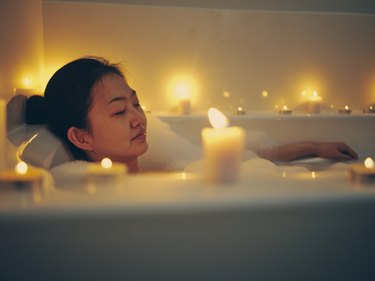
Self-care is a popular buzzword that gets tossed around a lot, especially during stressful times.
In the past year, you've probably read countless articles about "treating yourself," with suggestions for at-home spa days and such.
Video of the Day
Video of the Day
While bath bombs, scented candles and essential oils can help you unwind, self-care isn't just about getting a mani-pedi or a facial. In fact, it's doesn't always involve pampering yourself.
That's right: What many of us consider self-care is often confused with self-soothing, a related but separate skill in our wellness toolbox.
So, what's the difference between the two? Here, mental health experts help us define self-care and self-soothing and explain why we need each to be a healthy human being.
The Difference Between Self-Care and Self-Soothing
Self-soothing and self-care are both valuable tools in our wellness arsenal. And while the two practices are related, there are distinct differences, like timing. One contributes to future, long-lasting personal progress while the other deals with in-the-moment needs.
"Self-care practices support an individual's long-term growth and help people feel grounded and rooted," says Sahaj Kohli, founder of Brown Girl Therapy. In other words, self-care has an enduring effect on your mental (and physical) health.
Indeed, studies of the human brain show that certain forms of self-care — like developing resilience — literally rewire the brain to permanently restore calm, confidence and effectiveness, says psychologist Leo Flanagan, PhD, a trauma and resiliency expert.
Examples of self-care may include:
- Booking health-related appointments
- Refilling your prescriptions
- Staying hydrated
- Getting quality sleep
- Eating nutritious food
- Going to therapy
- Meditating daily
- Exercising regularly
- Planning a budget
- Organizing your finances
Alternatively, self-soothing practices are coping skills utilized in the moment of crisis, stress or overwhelm, Kohli says. They're short-term strategies that help comfort (or distract) us from our current circumstances.
Self-soothing techniques usually engage one or more of the five senses (think: a warm cup of herbal tea or a candlelit bubble bath) to temporarily block the input of perceived threats that send our anxiety into overdrive, Flanagan says. That is, self-soothing allows us to switch from a state of hyperarousal to a place of calm, at least for a brief period.
Every person is unique, so self-soothing can run the spectrum, but examples may include:
- Eating your favorite foods
- Getting a massage
- Having a cocktail
- Going shopping
- Binge-watching TV
Related Reading
When Do You Need Self-Care vs. Self-Soothing?
While self-care and self-soothing both play an important role in your wellness routine, when to employ each skill depends on context.
Self-care practices are proactive, Kohli says. We do them with intention to consciously bolster ourselves for the big picture. However, sometimes daily stress takes over and shifts us into survival mode. That's when we turn to self-soothing to cope with immediate situations.
After a tough day, sometimes you just need to skip the gym and veg out on the couch or miss a meditation session in favor of happy hour. "These behaviors aren't necessarily unhealthy when they are isolated," Kohli says.
But self-soothing isn't a substitute for self-care. And if your self-soothing behaviors consistently get in the way of doing things that will help you in the future, you need to pause and reflect, Kohli says.
For example, when your weekly manicure (self-soothing) interferes with your goals for financial planning or budgeting (self-care), that's a red flag.
Flanagan agrees that, in excess, certain self-soothing methods could sabotage your self-care. "Self-soothing techniques can end up being distractions that provide temporary relief with little long-term benefit," he says.
So, be honest with yourself: Spend time identifying how you engage in self-care and self-soothing to help you find a healthy balance that satisfies your needs in the now and simultaneously supports you in the long-term, Kohli says.
A Final Word
"Self-care [and self-soothing] practices don't look the same for everyone," Kohli says. This is especially true given the reality that certain self-care practices — like attending therapy, for example — can be out of reach for some and require a certain level of privilege, she says.
All this to say, what works for you may not work for your partner, family member or friend, and vice versa. What matters most is that self-care and self-soothing — in whichever forms they take — enhance and enrich your life.
Is this an emergency? If you are experiencing serious medical symptoms, please see the National Library of Medicine’s list of signs you need emergency medical attention or call 911.